임신 중 라임병, Lyme disease in Pregnancy
- 드물게, 임신부가 라임병에 걸려 유산을 할 수 있다.
- 독시싸이클린 Doxycycline으로 치료하지 않는 것이 보통이다.
- 임신부나 모유수유를 하는 수유모의 라임병은 Amoxicillin, ceftriaxone or cefotaxime 중 한 종류의 항생제로 치료한다.
- 예방 항생제 치료는 권장하지 않으나 때로는 Amoxicillin으로 10~14일 간 예방 치료한다.
- 참조 및 소스:HARVARD MEDICAL SCHOOL, INFECTIOUS DISEASES IN PRIMARY CARE OCTOBER 14-16, 2015,
- Red book 29th edition, 2015

사진 2-130. 보통 진드기의 사진
사슴 진드기 Nymphal stage의 실제 크기는 교과서의 종지부(Period)의 크기만 하다.
Copyright ⓒ 2011 John Sangwon Lee, MD. FAAP
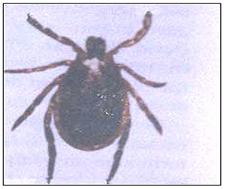
사진 2-131. 보통 진드기의 사진
사슴 진드기 Nymphal stage의 실제 크기는 교과서의 종지부(period)의 크기만 하다.
Copyright ⓒ 2011 John Sangwon Lee, MD. FAAP
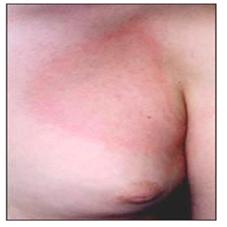
사진 2-132. 라임병으로 왼쪽 앞가슴에 난 유주성 홍반(이동 홍반)
이동 홍반은 진드기에 물린 1~2주 후 처음에는 작은 홍반성 구진으로 나타날 수 도 있고 홍반성 반점으로나타 날 수 있다. 그 후 점점 더 커진다.
이동 홍반 중심 부위에 물집이 잡힐 수도 있고 피부 조금이 괴사될 수 있다.
이동 홍반은 아무 증상이 없을 수도 있고 조금 가려울 수 있고 드믈게 아플 수 있다. 직경은 다양하나 드믈게는 61cm가 된다. 신체 피부 어디에든지 생길 수 있고 머리, 사타구니, 겨드랑이, 허리, 등, 다리 등에 날 수 있다. 전체가 일률적으로 붉든지 중심 부위가 더 붉을 수 있다.
이동 홍반이 있으면서 아무 증상도 나타나지 않을 수 있으나 때로는 피곤, 두통, 관절통, 근육통, 열 등 증상이 나타날 수 있다.
여러개 또는 단 한개만 나타날 수 있다. 자연히 없어지든지 치료 하면 없어진다.
소스;NEJM May 1 2014 p1724
Copyright ⓒ 2011 John Sangwon Lee, MD. FAAP

사진 2-133. 라임병으로 왼쪽 등에 난 유주성 홍반( (이동 홍반) ).
Copyright ⓒ 2011 John Sangwon Lee, MD. FAAP
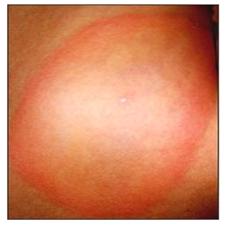
사진 2-134. 라임병으로 가슴에 난 유주성 홍반 (이동 홍반)
Copyright ⓒ 2011 John Sangwon Lee, MD. FAAP
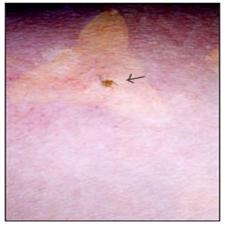
사진 2-135. 살갗을 물고 있는 진드기와 그 주위에 생긴 이동 홍반.
Copyright ⓒ 2011 John Sangwon Lee, MD. FAAP
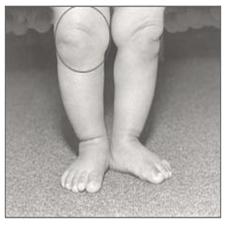
사진 2-136. 우 무릎관절이 라임병성 관절염(라임 병 관절염)으로 부었다.
Copyright ⓒ 2011 John Sangwon Lee, MD. FAAP
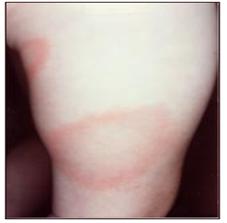
사진 2-137. 라임병으로 다리에 난 여러개의 이동 홍반(Erythema migrans)
Copyright ⓒ 2011 John Sangwon Lee, MD. FAAP
Lyme disease in Pregnancy 임신 중 라임병
Rarely, pregnant women can get Lyme disease and have a miscarriage.
It is usually not treated with doxycycline.
Lyme disease in pregnant women or breastfeeding mothers is treated with one type of antibiotic: amoxicillin, ceftriaxone or cefotaxime. Prophylactic antibiotic treatment is not recommended, but sometimes prophylactic treatment is performed with amoxicillin for 10 to 14 days.
References and Sources: HARVARD MEDICAL SCHOOL, INFECTIOUS DISEASES IN PRIMARY CARE OCTOBER 14-16, 2015, Red book 29th edition, 2015

Photo 2-130. Pictures of common ticks The actual size of the deer tick nymphal stage is only the size of the textbook period. Copyright ⓒ 2011 John Sangwon Lee, MD. FAAP

Photo 2-131. Pictures of common ticks The actual size of the deer tick nymphal stage is only the size of the period of the textbook. Copyright ⓒ 2011 John Sangwon Lee, MD. FAAP

Photo 2-132. Yujuseong erythema on the left anterior chest due to Lyme disease (mobile erythema) Migratory erythema may initially appear as small erythematous papules 1 to 2 weeks after being bitten by a tick, or as erythema spots.
After that, it gets bigger and bigger. Blisters may be caught in the central area of the erythema and a small amount of skin may be necrotized. Mobile erythema may have no symptoms, maybe a little itchy, and rarely hurt.
The diameter varies but rarely becomes 61cm. It can occur anywhere on the skin of the body and can fly to the head, groin, armpits, waist, back, and legs.
The whole may be uniformly red or the central part may be redder.
Movement erythema may be present and no symptoms, but sometimes symptoms such as fatigue, headache, joint pain, muscle pain, and fever may appear.
Multiple or only one can appear. Either it disappears naturally, or it disappears when treated. Source; NEJM May 1, 2014, p 1724 Copyright ⓒ 2011 John Sangwon Lee, MD. FAAP

Photo 2-133. Yujuseong erythema on the left back due to Lyme disease ((mobile erythema) ). Copyright ⓒ 2011 John Sangwon Lee, MD. FAAP

Photo 2-134. Yujuseong erythema on the chest due to Lyme disease (mobile erythema) Copyright ⓒ 2011 John Sangwon Lee, MD. FAAP

Photo 2-135. Skin-biting ticks and erythema moving around them. Copyright ⓒ 2011 John Sangwon Lee, MD. FAAP

Photo 2-136. The right knee joint was swollen due to Lyme disease arthritis (Lyme disease arthritis). Copyright ⓒ 2011 John Sangwon Lee, MD. FAAP

Photo 2-137. Multiple migration erythema on the leg due to Lyme disease (Erythema migrans) Copyright ⓒ 2011 John Sangwon Lee, MD. FAAP